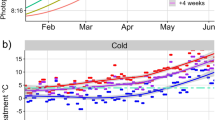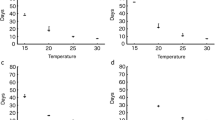Abstract
The impact of daily temperature fluctuations on arthropod life history parameters is inadequately studied compared with the ample amount of research that has been conducted on the effects of constant temperatures. Fluctuating temperatures are likely to be more realistic, as they are ecologically more similar to what these arthropods experience in nature. Here, we compared the impact of 11 constant temperatures that ranged from 10 to 35 °C with fluctuating temperatures with the same corresponding mean temperature and an amplitude of 10 °C between high (12 h) and low (12 h) temperatures on the development and life history parameters of Tetranychus urticae under continuous light conditions. No eggs hatched at constant 10 °C, whereas 81.5% of eggs successfully completed development at fluctuating 10 °C (15/5 °C). Egg-to-female adult development was faster under fluctuating temperatures from 12.5 to 27.5 °C than under constant temperatures, whereas the opposite trend was observed at >30 °C. The lower thermal thresholds (T) were 11.63 and 8.63 °C, and thermal constants (K) were 127.81 and 150.69 degree-days for egg-to-female adults at constant and fluctuating temperatures, respectively. The numbers of oviposition days were significantly higher at fluctuating 15 °C than at the corresponding constant temperature, whereas the opposite trend was observed from 20 to 30 °C. The intrinsic rate of increase (r) was higher at fluctuating than at constant 15 °C. The net reproductive rate (R 0) was also higher at fluctuating than at constant 15 and 35 °C, but showed an opposite trend at 20 and 25 °C. We conclude that fluctuating temperatures should be considered to accurately predict spider mite population dynamics in nature.










Similar content being viewed by others
References
Akca I, Ayvaz T, Yazici E, Smith CI, Chi H (2015) Demography and population projection of Aphis fabae (Hemiptera: Aphididae): With additional comments on life table research criteria. J Econ Entomol 108:1466–1478
Atkinson D (1996) Ectotherm life history responses to developmental temperature. In: Johnston IA, Bennett AF (eds) Animals and temperature: Phenotypic and evolutionary adaptation. Cambridge University Press, Cambridge, pp 183–204
Blanford JI, Blanford S, Crane RG, Mann ME, Paaijmans KP, Schreiber KV (2013) Implications of temperature variation for malaria parasite development across Africa. Sci Rep 3:1300
Campbell A, Frazer BD, Gilbert N, Gutierrez AP, Mackauer M (1974) Temperature requirements of some aphids and their parasites. J Appl Ecol 11:431–438
Chi H (1988) Life-table analysis incorporating both sexes and variable development rates among individuals. Environ Entomol 17:26–34
Chi H (2017) TWOSEX-MSChart: a computer program for the age-stage, two-sex life table analysis. (http://140.120.197.173/Ecology/prod02.htm). Accessed 8 April 2017
Chi H, Liu H (1985) Two new methods for the study of insect population ecology. Bull Inst Zool Acad Sin 24:225–240
Collinet H, Nguyen TTA, Cloutier C, Michaud D, Hance T (2007) Proteomic profiling of a parasitic wasp exposed to constant and fluctuating cold exposure. Insect Biochem Mol 37:1177–1188
Davis IA, Radcliffe EB, Ragsdale DW (2006) Effects of high and fluctuating temperatures on Myzus persicae (Hemiptera: Aphididae). Environ Entomol 35:1461–1468
Delava E, Fleury F, Gibert P (2016) Effect of daily fluctuating temperatures on the Drosophila-Leptopilina boulardi parasitoid association. J Therm Biol 60:95–102
Efron B, Tibshirani RJ (1993) An introduction to the bootstrap. Chapman & Hall, New York
Eichmeier J, Guyer G (1960) An evaluation of the rate of reproduction of the two-spotted spider mites reared on gibberellin-treated bean plants. J Econ Entomol 53:661–664
Fantinou AA, Perdikis DC, Chatzoglou CS (2003) Development of immature stages of Sesamia nonagrioides (Lepidoptera: Noctuidae) under alternating and constant temperature. Environ Entomol 32:1337–1342
Fisher RA (1930) The genetical theory of natural selection. Clarendon Press, Oxford
Foray V, Desouhant E, Gibert P (2014) The impact of thermal fluctuations on reaction norms in specialist and generalist parasitic wasps. Funct Ecol 28:411–423
Golikhajeh N, Naseri B, Razmjou J (2016) Effect of geographic population and host cultivar on demographic parameters of Spodoptera exigua (Hübner) (Lepidoptera: Noctuidae). J Asia-Pac Entomol 19:743–751
Gotoh T, Sugimoto N, Pallini A, Knapp M, Hernandez-Suarez E, Ferragut F, Ho C-C, Migeon A, Navajas M, Nachman G (2010) Reproductive performance of seven strains of the tomato red spider mite Tetranychus evansi (Acari: Tetranychidae) at five temperatures. Exp Appl Acarol 52:239–259
Gotoh T, Saito M, Suzuki A, Nachman G (2014) Effects of constant and variable temperatures on development and reproduction of the two-spotted spider mite Tetranychus urticae (Acari: Tetranychidae). Exp Appl Acarol 64:465–478
Haavik LJ, Meeker JR, Johnson W, Ryan K, Turgeon JJ, Allison JD (2013) Predicting Sirex noctilio and S. nigricornis emergence using degree days. Entomol Exp Appl 149:177–184
Hagstrum DW, Leach CE (1973) Role of constant and fluctuating temperatures in determining development time and fecundity of three species of stored-products Coleoptera. Ann Entomol Soc Am 66:407–410
Huang YB, Chi H (2012) Life tables of Bactrocera cucurbitae (Diptera: Tephritidae): with an invalidation of the jackknife technique. J Appl Entomol 137:327–339
Liu SS, Zhang GM, Zhu J (1995) Influence of temperature variations on rate of development in insects: analysis of case studies from entomological literature. Ann Entomol Soc Am 88:107–119
Lopatina EB, Kipyatkov VE, Balashov SV, Kutcherov DA (2011) Photoperiod–temperature interaction-a view form of seasonal control of growth and development in insects and in particular a Carabid beetle, Amara communis (Coleoptera: Carabidae). J Evol Biochem Physiol 47:578–592
Luedeling E, Steinmann KP, Zhang MA, Brown PH, Grantz J, Girvetz EH (2011) Climate change effects on walnut pests in California. Glob Chang Biol 17:228–238
MacMillan HA, Williams CM, Staples JF, Sinclair BJ (2012) Reestablishment of ion homeostasis during chill-coma recovery in the cricket Gryllus pennsylvanicus. Proc Natl Acad Sci 109:20750–20755
Malaquias JB, Ramalho FS, Fernandes FS, Junior JLN, Correia ET, Zanuncio JC (2010) Effect of photoperiod on reproduction and longevity of Podisus nigrispinus (Heteroptera: pentatomidae). Ann Entomol Soc Am 103:603–610
Marshall KE, Sinclair BJ (2010) Repeated stress exposure results in a survival-reproduction trade-off in Drosophila melanogaster. Proc R Soc Lond B 277:963–969
Migeon A, Dorkeld F (2006-2017) Spider mites web: a comprehensive database for the Tetranychidae. http://www.montpellier.inra.fr/CBGP/spmweb. Accessed May 2017
Mironidis GK (2014) Development, survivorship, and reproduction of Helicoverpa armigera (Lepidoptera: Noctuidae) under fluctuating temperatures. Bull Entomol Res 104:751–764
Mironidis GK, Savopoulou-Soultani M (2008) Development, survivorship, and reproduction of Helicoverpa armigera (Lepidoptera: Noctuidae) under constant and alternating temperatures. Environ Entomol 37:16–28
Mou DF, Lee CC, Smith CL, Chi H (2015) Using viable eggs to accurately determine the demographic and predation potential of Harmonia dimidiata (Coleoptera: Coccinellidae). J Appl Entomol 139:579–591
Myster J, Moe R (1995) Effect of diurnal temperature alternations on plant morphology in some greenhouse crops- a mini review. Sci Hort 62:205–215
Paaijmans KP, Heinig RL, Seliga RA, Blanford JI, Blanford S, Murdock CC (2013) Temperature variation makes ectotherms more sensitive to climate change. Glob Chang Biol 19:2373–2380
Riahi E, Shishehbor P, Nemati AR, Saeidi Z (2013) Temperature effects on development and life table parameters of Tetranychus urticae (Acari: Tetranychuidae). J Agric Sci Tech 15:661–672
Stavang JA, Lindgard B, Erntsen A, Lid SE, Moe R, Olsen JE (2005) Thermoperiodic stem elongation involves transcriptional regulation of gibberellin deactivation in pea. Plant Phys 138:2344–2353
Sugawara R, Ullah MS, Ho C-C, Gökçe A, Chi H, Gotoh T (2017) Temperature-dependent demography of two closely related predatory mites Neoseiulus womersleyi and N. longispinosus (Acari: Phytoseiidae). J Econ Entomol (in press)
Terblanche JS, Nyamukondiwa C, Kleynhans E (2010) Thermal variability alters climatic stress resistance and plastic responses in a globally invasive pest, the Mediterranean fruit fly (Ceratitis capitata). Entomol Exp Appl 137:304–315
Tuan S-J, Lin Y-H, Yang C-M, Atlihan R, Saska P, Chi H (2016) Survival and reproductive strategies in two-spotted spider mites: demographic analysis of arrhenotokous parthenogenesis of Tetranychus urticae (Acari: Tetranychidae). J Econ Entomol 109:502–509
Ullah MS, Lim UT (2015) Life history characteristics of Frankliniella occidentalis and Frankliniella intonsa (Thysanoptera: Thripidae) in constant and fluctuating temperatures. J Econ Entomol 108:1000–1009
Ullah MS, Moriya D, Badii MH, Nachman G, Gotoh T (2011) A comparative study of development and demographic parameters of Tetranychus merganser and Tetranychus kanzawai (Acari: Tetranychidae) at different temperatures. Exp Appl Acarol 54:1–19
Ullah MS, Haque MA, Nachman G, Gotoh T (2012) Temperature-dependent development and reproductive traits of Tetranychus macfarlanei (Acari: Tetranychidae). Exp Appl Acarol 56:327–344
Vangansbeke D, Schrijver LD, Spranghers T, Audenaert J, Verhoeven R, Nguyen DT, Gobin B, Tirry L, De Clercq P (2013) Alternating temperatures affect life table parameters of Phytoseiulus persimilis, Neoseiulus californicus (Acari: Phytoseiidae) and their prey Tetranychus urticae (Acari: Tetranychidae). Exp Appl Acarol 61:285–294
Vangansbeke D, Audenaert J, Nguyen DT, Verhoeven R, Gobin B, Tirry L, De Clercq P (2015) Diurnal temperature variation affect development of a herbivorous arthropod pest and its predator. PLoS ONE 10:e0124898
Wang S, Tan X-L, Guo X-J, Zhang F (2013) Effect of temperature and photoperiod on the development, reproduction, and predation of the predatory ladybird Cheilomenes sexmaculata (Coleoptera: Coccinellidae). J Econ Entomol 106:2621–2629
Zerbino MS, Altier NA, Panizzi AR (2013) Effect of photoperiod and temperature on nymphal development and adult reproduction of Piezodorus guildinii (Heteroptera: Pentatomidae). Fla Entomol 96:572–582
Zhou L, Dai A, Dai Y, Vose RS, Zou CZ, Tian Y, Chen H (2009) Spatial dependence of diurnal temperature range trends on precipitation from 1950 to 2004. Clim Dynam 32:429–440
Zou Z, Min Q, Xiao S, Xin T, Xia B (2016) Effect of photoperiod on development and demographic parameters of Neoseiulus barkeri (Acari: Phytoseiidae) fed on Tyrophagus putrescentiae (Acari: Acaridae). Exp Appl Acarol 70:45–56
Acknowledgements
We are thankful to Dr. Yasuki Kitashima, Ibaraki University, Japan, for help conducting this study and Indonesian Agency for Agricultural Research and Development (IAARD) who supported MSYIB to conduct the study. We also thanks to Dr. Hsin Chi, National Chung Hsing University, Taiwan, for his suggestions on the analysis of the data.
Author information
Authors and Affiliations
Corresponding author
Rights and permissions
About this article
Cite this article
Bayu, M.S.Y.I., Ullah, M.S., Takano, Y. et al. Impact of constant versus fluctuating temperatures on the development and life history parameters of Tetranychus urticae (Acari: Tetranychidae). Exp Appl Acarol 72, 205–227 (2017). https://doi.org/10.1007/s10493-017-0151-9
Received:
Accepted:
Published:
Issue Date:
DOI: https://doi.org/10.1007/s10493-017-0151-9




